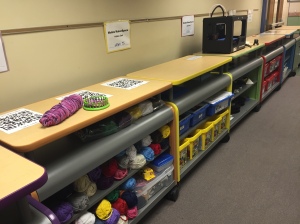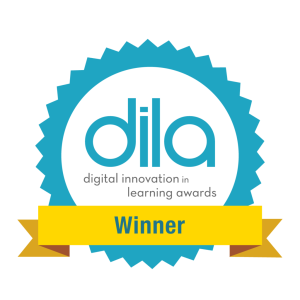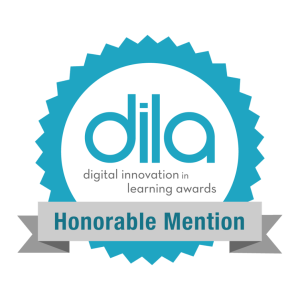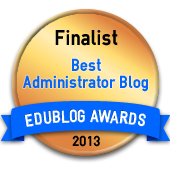Blog Archives
Lunch & Tweet with the Commissioner

Join us for a “Lunch & Tweet” with Minnesota’s Commissioner of Education, Dr. Brenda Cassellius, on April 20th at 12:30pm CST.
Feel free to invite a colleague or fellow educator to participate. The questions we’ll be discussing are listed below. This is a great opportunity to dialogue with other educators who are committed to the success of Minnesota students.
Q1. What is working for Minnesota students? Share something great happening in your school. #MESPAmn
Q2. How are you helping all students and families connect and “belong” in your school? #MESPAmn
Q3. What is one thing you are learning, or hope to learn, to improve your leadership? #MESPAmn
Q4. What are some strategies your school is using to promote equity and close the achievement gap? #MESPAmn
Q5. Where do you see the greatest need in PreK education? #MESPAmn
Q6. Let’s talk pedagogy and innovation. How are you preparing students for their future? #MESPAmn
Can MakerSpaces Invent the Future? (Video)
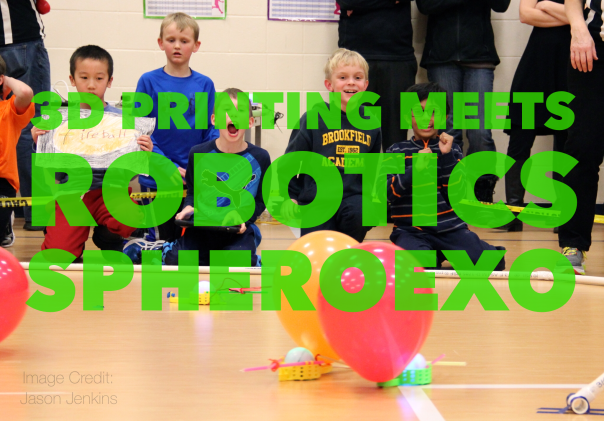 It is incredible what kids can do when we believe in them, coach them, and get out of their way! Our students recently participated in a robotics competition that was invented from the ground up by staff and students. We designed and printed 3D “exoskeletons” that fit over our Sphero robotic droids…and SpheroExo was born. The rest is history.
It is incredible what kids can do when we believe in them, coach them, and get out of their way! Our students recently participated in a robotics competition that was invented from the ground up by staff and students. We designed and printed 3D “exoskeletons” that fit over our Sphero robotic droids…and SpheroExo was born. The rest is history.
Check out the 5 minute video below and prepare to be amazed at what kids can do.
We are so proud of our students and all they are creating, engineering, and achieving. Watch for our students next week as they present SpheroExo to teachers at EdCamp Eau Claire! Students will be sharing their design process and how they’re inventing the future at #EdCampEC.
I’m not sure that MakerSpaces can actually invent the future, but I’m very confident that cutting-edge tools and a culture conducive to innovation helps. A relevant and connected pedagogy empowers all kids to create, connect, and dream bigger.
Kindergarten Engineers (Video)

Recently, one of our kindergarten classes worked on a standards-based engineering challenge, and the results were incredible. The truth of the matter is this type of “incredible” is something I see on a daily basis in classrooms across our school. Sometimes I’m able to take a few pictures (or video) and other times I simply stand in awe of the passion and skill our teachers possess. I am amazed at how our team cultivates skills that help students thrive today and excel tomorrow.
When all is said and done, the transmission of graphite to paper provides important practice and achievement data. However, it’s the transmission of curiosity that transcends time. Learning how to learn, overcoming failure, and working together to create something more beautiful than any of us could create alone is where the magic is. When digital age skills and a relevant pedagogy are part of the achievement process kids win.
This three minute VIDEO highlights the process we used for a lesson with Edison robots. Getting a glimpse of the conversation and steps our kindergarten students followed is pretty special. I also think that sharing some of the activities that our teachers are facilitating is good for all kids. When educators share their insights a global ecosystem of learners benefits from the ensuing conversations. Shining the light on best practices, innovation, and the work our dedicated teachers are doing helps us all understand how we might serve students in a more relevant and relational manner. It’s not about the robots!
Edison robots are the tool featured in this video, but they are not the reason this learning experience was incredible. The mindset and approach that Mrs. Amy Westman used made this learning transformational for kids. (A connected teacher with a growth-mindset is more important than any robotic device.) Amy and her colleagues demonstrate this on a daily basis. I’d suggest following @MrsAmyWestman on Twitter. She’s one of seven phenomenal kindergarten teachers in our school, and she shares some great learning highlights throughout the week.
Standards and Mobile MakerSpaces:
Lastly, one of the kindergarten standards that guided the lesson was 0.8.1.1 1. “Prepare for and participate effectively in a range of conversations and collaborations with diverse partners, building on others’ ideas and expressing their own clearly and persuasively.” We used one of our Mobile MakerSpace carts to bring this challenge to students, and to breathe relevance into the standards.
Classroom Twitter Chat #StuConnect
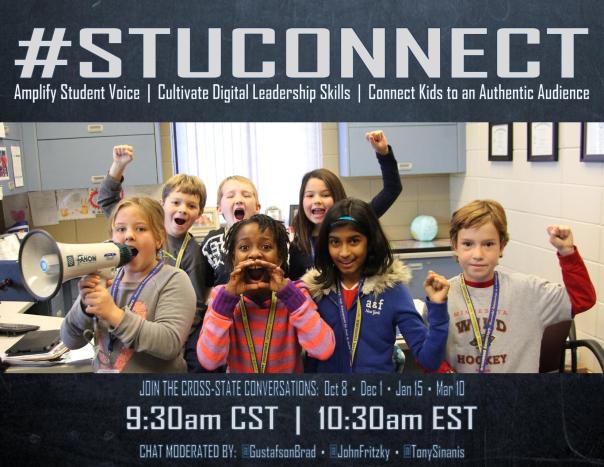
Join classrooms across the country as we celebrate the books we love on Friday, January 15, 2016 at 9:30am CST. Be sure to add the #StuConnect hashtag to your classroom tweets when responding to the questions below.
Q1 What book are you reading independently right now? What book is your teacher reading aloud to you? Which would you recommend?!
Q2 If you could meet a favorite character from a book, who would you choose?
Q3 What’s on your classroom’s Top 10 “Must Read” list?
Q4 If you could create a new book award what would you name it? What book would you nominate and why?
The entire twitter chat will only last 15-30 minutes. Feel free to join us for one question or stick around for the entire chat. All grade-levels are welcome to participate.
We will share out a new question every five minutes or so. Classrooms can respond to specific questions by starting their Tweets with the letter “A” (stands for Answer) and adding the hashtag #StuConnect to the very end of each Tweet.
Feel free to prepare pictures and video ahead of time. For example, if your students would rather design a new book award drawing to respond to question four they are more than welcome to. Creativity is appreciated, but a love of literacy and cultivating digital leadership skills are the ultimate goals!
Special thanks to my friends and #StuConnect co-moderators John Fritzky (NJ) and Tony Sinanis (NY). We’ll also be joined by a Greenwood student serving as honorary co-moderator and “Principal for the Day!” We hope you can join us for the live Twitter chat at 9:30am CST on Friday, January 15th.
Within Reach

The teacher-observation process provides me access and insight into classroom learning experiences that very few people have. I’m consistently inspired by the relevant and connected learning I observe. Recently I was in a classroom and I didn’t want the lesson to end. As I was watching the lesson unfold, I knew that what I was experiencing was also within reach of classrooms and schools everywhere.
Here are some of the salient things I observed during the lesson:
- I observed an elementary Language Arts lesson.
- A clear learning target based upon state standards guided the learning process.
- The teacher used one of our Mobile MakerSpace carts to teach students how to create an alternate ending to a text by manipulating various elements of the plot.
- Students constructed models depicting their alternate story endings using Lego building bricks from the MakerSpace cart.
- Students were empowered to collaborate on plans for their alternate story endings and projects.
- Students had opportunities to talk, create, experiment, fail, and redesign.
- The teacher purposefully connected with individual students and small groups to elicit high-level thinking and scaffold as appropriate.
- Formative assessment was seamlessly interwoven through the lesson.
- Students presented their creations to the class near the conclusion of the lesson. This public speaking provided students time to explain their thinking, and the teacher was able to use some metacognition connected to the learning target.
- Students used digital tools to curate their work so it could be referenced in the future and shared with parents.
- As part of this process, students photographed their projects and uploaded them to Google Drive to share their learning with their families.
- Students did not want the lesson to end. (Based on what I was seeing, kids would’ve opted to skip recess if given the opportunity.)
- The teacher ensured that the lesson was led by learning; not tools, technology, or activities.
- This was an authentic learning experience that was scholarly and highly relational.
Did I mention that this was a kindergarten language arts lesson?! That’s right…our youngest learners were empowered to innovate, collaborate, present, and curate their work using digital tools.
At one point one of the kindergarteners yelled out in exuberence, “Teacher…we’re engineering!” and her amazing teacher responded, “Yes…you are designing and building.” Kids were making connections to past conversations about design, building, and engineering.
During our observation post-conference I invited the teacher to share her reflections in a blog post instead of the traditional electronic form required by the district. I knew that we could meet the requirements of the standard district form by copy/pasting reflections from a blog post if the teacher was interested in pursuing this. (Stay tuned for her reflections and first blog post…)
I am convinced that a paradigm shift is underway in education because I see it every day at Greenwood Elementary. A new and connected learning paradigm that puts students in the center of their learning is possible. Deeper learning that’s both relevant and connected is within reach!

Image Credits:
1.) “Sparkler” photo from Pixabay (Creative Commons)
2.) “Kindergarten Collaboration & Digital Curation” photo from Greenwood Elementary
StuConnect Classroom Twitter Chat

Join classrooms across the country as we celebrate student passion on December 1st at 9:30am CST. Click HERE to watch a short (3 minute) podcast prepared by students in two different states. Then join the conversation this Tuesday by tagging your classroom Tweets with the hashtag #StuConnect.
The entire chat will only last 20-30 minutes. Feel free to join us for one question or stick around for the entire chat. All grade-levels are welcome to participate. We will share out a new question every 6-7 minutes. Classrooms can respond to specific questions by starting their Tweets with the letter “A” (stands for Answer) and adding the hashtag #StuConnect to the very end of each Tweet.
A preview of the questions is below:
- Introduce your classroom or school and share what state you are from. #StuConnect
- Q1 What are your passions and talents? #StuConnect
- Q2 Why is knowing what you are talented at important? #StuConnect
- Q3 How do you get to ‘practice your passion’ in school? #StuConnect
- Q4 Where else do you get to spend time in an area interest? How might school help with this? #StuConnect
Special thanks to my #StuConnect co-moderators John Fritzky (NJ) and Tony Sinanis (NY) as well as one of our fabulous student-teachers, Ms. Frick, for helping produce the podcast. We hope you can join us for the Twitter chat at 9:30am CST on Tuesday, December 1st, 2015!
The Rush

Image Credit: http://www.dumblittleman.com
There is no shortage of passion in education. Teachers work tirelessly to meet the needs of their students, often sacrificing family time and resources in the process. Their commitment to discover new tools and techniques to make a difference for kids is one of the best untold stories in education.
At the same time, external pressures and conflicting mandates have created some very challenging conditions for teachers. I’ve noticed that all of these factors have perpetuated a rush of sorts.
Notably absent in the rush is a deeper dialog about pedagogy. Educators rush to new ideas in pursuit of different ways to inspire students, or just the opposite. We may rush to repeat the same routines that worked well in previous year(s). Whether we are rushing to bring new opportunities to our students, or confronted by the lure of efficiency that the status quo offers; pedagogy needs to play a more prominent role in the rush.
- Before we rush to [insert educational trend here] we need to reflect upon the purpose.
- Before we rush to [insert past-practice here] we need to consider a more relevant and connected pedagogy.
Communicating precisely what a connected pedagogy is (and is not) becomes vitally important to ensuring we’re rushing to the right (and relevant) things for our students. The short video below is a humorous take on what happens when we say the same thing, but understand it differently than others. Pedagogy is an example of a word that many educators use, but we all understand it differently.
I’ve identified four tenets of a connected pedagogy that will empower educators to do the difficult work they’ve dedicated their lives to. The tenets take the ambiguity out of the term “pedagogy” and illuminate a path that will cultivate skills for today’s learners. The blog posts that I’ve linked to each tenet are basic conversation starters.
When we prioritize purpose and rush to a relevant & connected pedagogy the work becomes more significant.

Image Credit: http://www.brainyquote.com
Perspective

Image Credit: http://www.themarketworld.com
What do you notice about this picture? It doesn’t really bother me that the people are moving in different directions. In fact, I think moving in the same direction without questioning our purpose could be dangerous. In some ways this is analogous to education.
Education is filled with some of the most dedicated and selfless individuals on the planet. These people are trying to make a difference for kids in the best way they know how. Some strive to integrate technology while others question its utility. Neither approach is inherently wrong, but there has to be a purpose and pedagogy behind our teaching that is just as important as the teaching itself.
Before we dip our oars in the water we should be able to identify two things:
- Purpose: Why is the direction, idea, or path we’re pursuing important to our students?
- Pedagogy: How might the approach we take be more relevant to the lives of our students?
All students deserve the opportunity to experience a relevant and connected pedagogy that leverages the promises of the digital age. This does not mean that every learning experience needs to involve a device or Wi-Fi. It does mean that the context in which we are teaching has changed dramatically and the pedagogy we implore must be responsive to these changes. Creativity and collaboration are not soft skills that can be sacrificed in the pursuit of student achievement. The pedagogy we implore must prioritize digital age skills and tools while helping all students learn at a high level.
Perhaps a new direction is warranted. What’s your perspective?
Mobile MakerSpaces in Action (Video)
The entire concept is really quite simple. The Mobile MakerSpace carts that line the hallway leading into our Media Center are capable of transporting new opportunities and tools to virtually any space in our school. Whether it’s high-tech 3D printing and modular robotics or low-tech knitting and plastic construction blocks…the carts contain tools that elicit collaboration and unleash student creativity.
When coupled with our amazing team of teachers the impact is quite profound.
Our teachers continue to integrate collaboration, creativity, and ‘making’ into the student learning experience in a variety of ways. In addition to our Mobile MakerSpace Fleet, new instructional approaches like Genius Hour, flipped instruction, connected learning, and math workshop contribute to a relevant pedagogy. Best practices in literacy instruction, assessment, and classroom discussions further contribute to meaningful learning experiences. Staff are engaged in a variety of passions that contribute to a culture of learning and innovative school ethos.
The time, energy, and learning that our team invests into reinventing themselves for kids each year is nothing short of inspiring.
We continue to expand upon student opportunities based on input from our students and staff. This year we’re adding another five or six carts that students will have access to. Be sure to watch the short video in this blog post to see how our Mobile MakerSpaces work.
Finally, stay tuned for a unique opportunity for YOUR students to design and propose our next Mobile MakerSpace cart! It’s going to be AWESOME!

